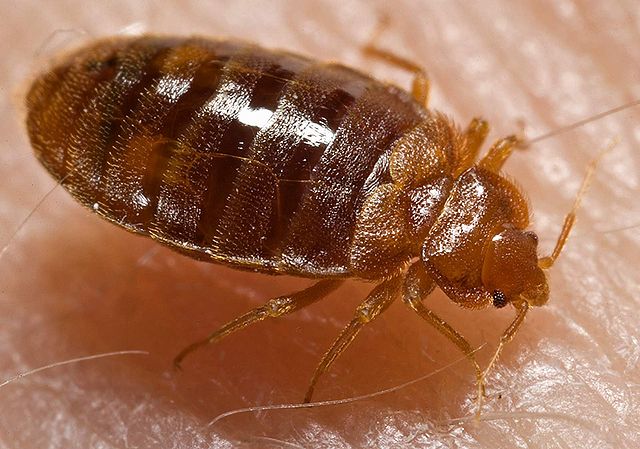 |
This is a file from the Wikimedia Commons. Information from its description page there is shown below.
Commons is a freely licensed media file repository. You can help.
|
Summary
| Description |
ID#: 9822 This 2006 photograph depicted an oblique-dorsal view of a bed bug nymph (?), Cimex lectularius, as it was in the process of ingesting a blood meal from the arm of a “voluntary” human host.
Bed bugs are not vectors in nature of any known human disease. Although some disease organisms have been recovered from bed bugs under laboratory conditions, none have been shown to be transmitted by bed bugs outside of the laboratory.
The common bed bug is found worldwide. Infestations are common in the developing world, occurring in settings of unsanitary living conditions and severe crowding. In North America and Western Europe, bed bug infestations became rare during the second half of the 20th century and have been viewed as a condition that occurs in travelers returning from developing countries. However, anecdotal reports suggest that bed bugs are increasingly common in the United States, Canada, and the United Kingdom.
C. lectularius inject saliva into the blood stream of their host to thin the blood, and to prevent coagulation. It is this saliva that causes the intense itching and welts. The delay in the onset of itching gives the feeding bed bug time to escape into cracks and crevices. In some cases, the itchy bites can develop into painful welts that last several days. Bed bug bites are difficult to diagnose due to the variability in bite response between people, and due to the change in skin reaction for the same person over time. It is best to collect and identify bed bugs to confirm bites. Bed bugs are responsible for loss of sleep, discomfort, disfiguring from numerous bites and occasionally bites may become infected. |
| Date |
2006 |
| Source |
http://phil.cdc.gov/phil |
| Author |
Content Providers(s): CDC/ Harvard University, Dr. Gary Alpert; Dr. Harold Harlan; Richard Pollack. Photo Credit: Piotr Naskrecki |
Permission
( Reusing this file) |
Copyright Restrictions: None - This image is in the public domain and thus free of any copyright restrictions. As a matter of courtesy we request that the content provider be credited and notified in any public or private usage of this image.
|
Licensing
| Public domainPublic domainfalsefalse |
 |
This image is a work of the Centers for Disease Control and Prevention, part of the United States Department of Health and Human Services, taken or made as part of an employee's official duties. As a work of the U.S. federal government, the image is in the public domain.
česky | Deutsch | English | español | eesti | suomi | français | italiano | македонски | Nederlands | polski | português | slovenščina | 中文 | 中文(简体) | +/−
|
|
File usage
The following pages on Schools Wikipedia link to this image (list may be incomplete):
SOS Children chose the best bits of Wikipedia to help you learn. SOS Children's Villages believes education is an important part of a child's life. That's why we ensure they receive nursery care as well as high-quality primary and secondary education. When they leave school, we support the children in our care as they progress to vocational training or higher education. Find out more about sponsoring a child.



